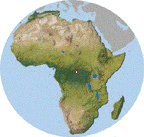 Lomako
Lomako Lomako
Lomako---
Primary source for the following Site Data is McGrew et. al. (1996), Great Ape Societies (Cambridge University Press), Appendix.
| Name: | Lomako |
| Location: | D. R. Congo [ex-Zaire], Province de Equateur, 0° 51' N, 21° 5' E |
| Status: | Unprotected, timber concession granted |
| Area: | 30km2 in 3500km^2 of undisturbed forest |
| Altitude: | 390m |
| Temp: | --- °C |
| Rainfall: | 1850mm (1994) |
| Vegetation: | Polyspecific primary forest, primary evergreen forest, swamp forest |
|
Human influence: |
Hunting mostly with bow and arrow, snaring, gathering of
fruit, honey, leaves, medicinal plants, fishing, no provisioning Disturbance ratings -- 2, 1, 1, 3, 1 |
|
Closest village: | 2km |
|
Species studied: | P. paniscus (Eyengo community) |
|
Population density: | --- individuals per km2 |
| Fauna: | Perodicticus potto, Galago demidovii, Colobus angolensis, Cercopithecus ascanius, C. mona, Cercocebus aterrimus, Panthera pardus |
|
Study period: | 1974-91 intermittent by SUNY Stony Brook; Project Pan 1990- present |
| Habituation: | Good |
|
Research presence: | Seasonal |
| Conservation: | None |
|
Current research: | Communication, socio-ecology of nest building, social organization, food sharing, play |
| Methods: | focal-subject sampling, nest-to-nest, ad libitum |
|
Contact person: | Gottfried Hohmann/Barbara Fruth, Max-Planck-Institut fur Verhaltensphysiologie, D-82319 Seewiesen, Germany |
| Habitat photos | --- |
| Maps | --- |
| Aerial photos | --- |
| Bibliography | References for data found in this site, and other sources relating to Lomako |
| |
| Miscellaneous | Related links |